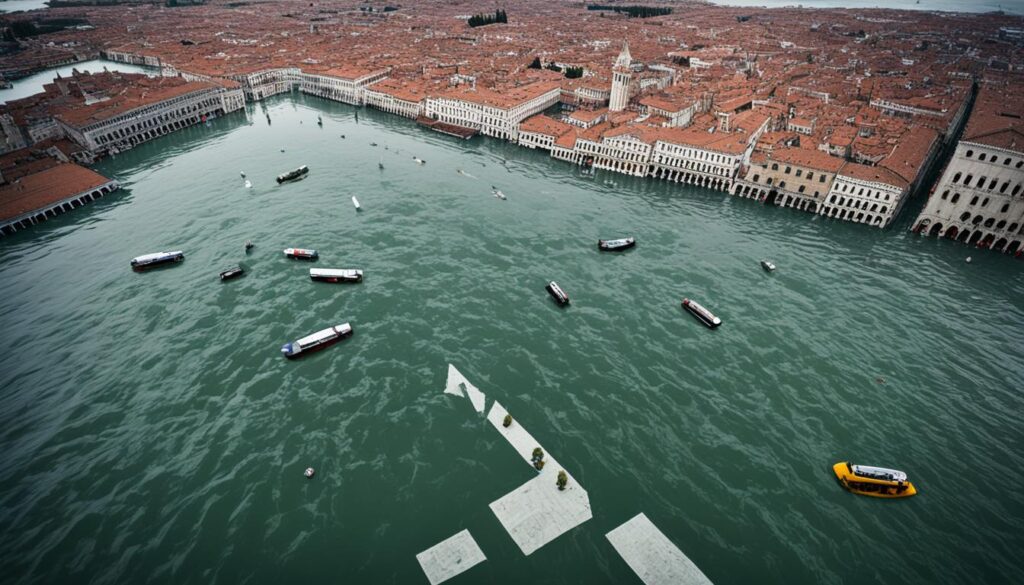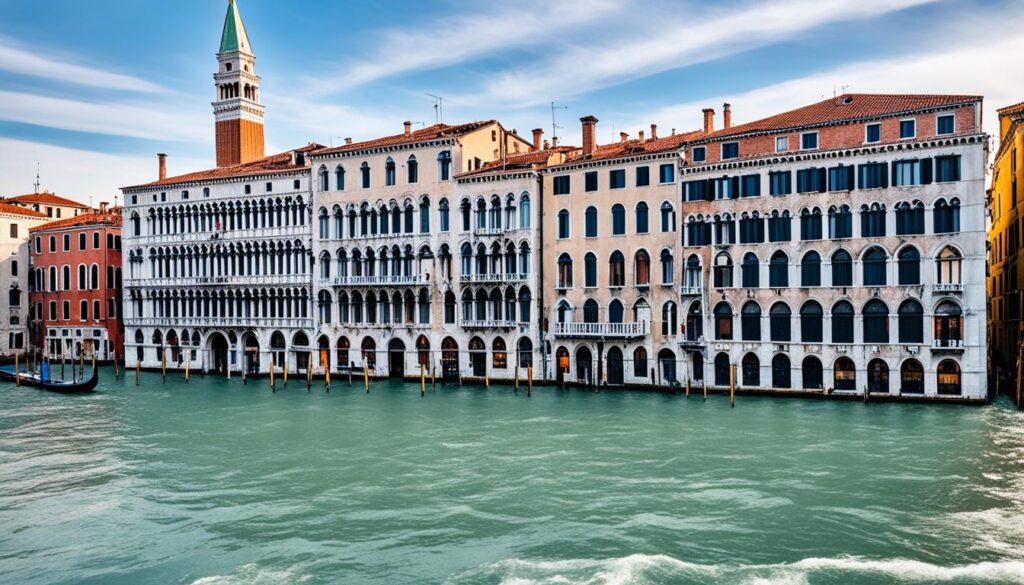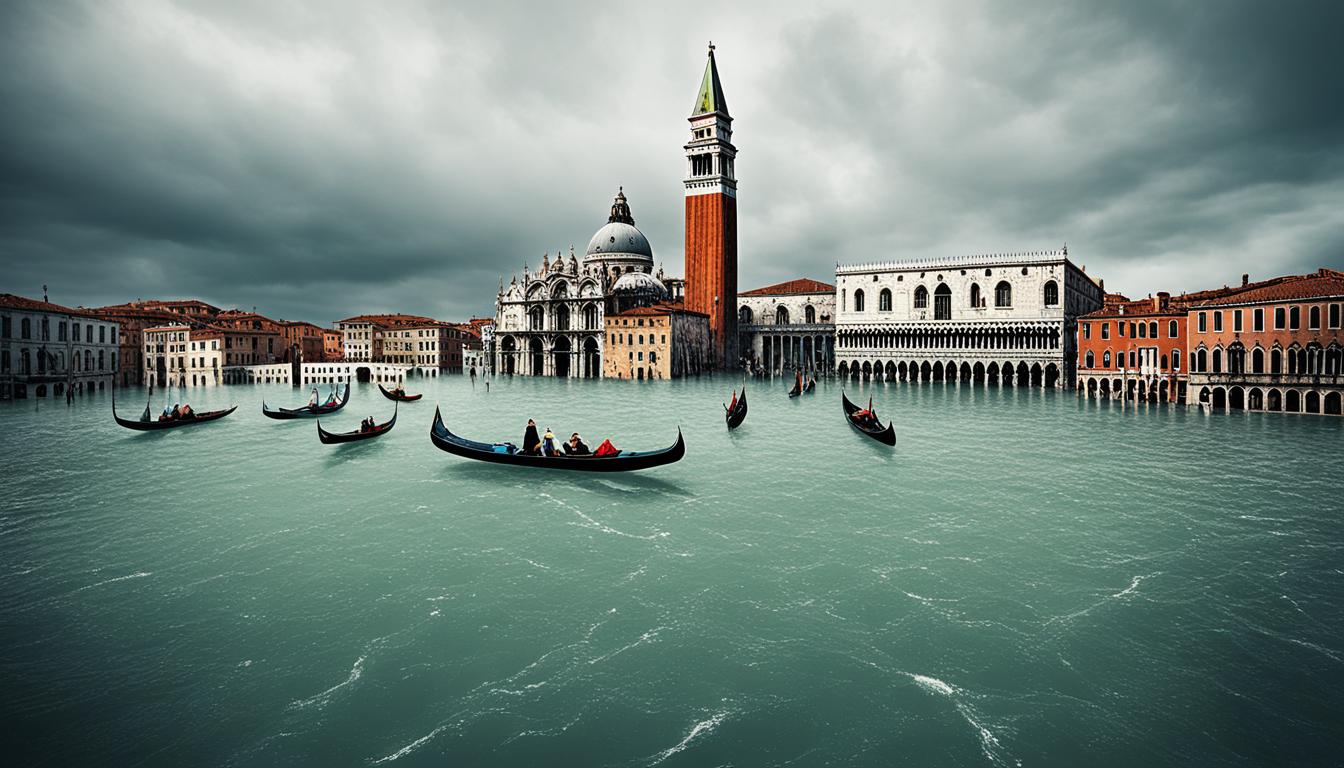Venice, famous for its beautiful canals, historic buildings, and lively culture, is in danger from climate change. Sea levels are rising, and the city is sinking. People wonder: When will Venice sink into the sea?
Venice sits in a shallow lagoon, making it prone to floods. But now, sea levels are rising faster, and the city is sinking more. Experts say parts of Venice might be underwater by 2150. The city will face more and more floods in the next few decades.
Key Takeaways
- Venice is at risk of disappearing due to rising sea levels and sinking foundations.
- Projections suggest parts of Venice could be submerged by 2150, with more frequent and severe flooding in the coming decades.
- The city’s unique geography and low-lying position make it particularly vulnerable to the impacts of climate change.
- Efforts to protect Venice, such as the MOSE project, face significant challenges and costs.
- Innovative solutions, including Dutch-style flood management systems, are being explored to safeguard Venice’s future.
Venice’s Unique Geographical Position
Venice is a city like no other, built on about 120 small islands in a shallow venice lagoon. It’s filled with 177 venice canals and connected by 391 venice bridges. This creates a beautiful maze of water, paths, squares, and churches.
Built on Islands in a Shallow Lagoon
Long ago, people built Venice on these islands to escape invaders. Now, it’s at risk from rising sea levels and high tides. This unique venice geography makes Venice vulnerable.
Canals and Bridges: A Watery Maze
Exploring Venice’s venice canals and venice bridges is a big part of its charm. Gondolas and vaporetti take people through historic spots. But, this beauty also shows how fragile Venice is as the sea level rises.
| Venice Factoids | Data |
|---|---|
| Number of Islands | Around 120 |
| Number of Canals | 177 |
| Number of Bridges | 391 |
“Venice is a city that is always under threat from the sea, and the threat is becoming more severe with the impact of climate change.”
–Luca Zaia, President of the Veneto Region
The Threat of Rising Sea Levels
Venice, famous for its canals and stunning architecture, faces a big threat from rising sea levels. Even if global temperatures don’t rise too much, Venice could see a 32 centimeter sea level increase by 2100. If temperatures go up by 4°C, the sea level could hit 180 centimeters, similar to the 2019 floods.
Sea Level Rise Projections for Venice
Since 1872, Venice’s sea level has risen by about 32 centimeters. This trend is expected to get worse because of climate change. Venice’s geography makes it very vulnerable to high tides and storm surges.
Impacts of High Tides and Storm Surges
- High tides, or “acqua alta,” often flood Venice’s streets and piazzas, affecting daily life and the city’s heritage.
- Storm surges, made worse by rising seas, threaten Venice’s buildings and the people who live and work there.
- The constant flooding and the need to balance tourism with local life raise big questions about Venice’s future.
“Venice may disappear by crumbling away by 2100.” – Climate Change Expert
| Flooding Event | Water Level | Impact |
|---|---|---|
| 2019 Floods | 180 cm (70.9 inches) | Widespread damage to historic buildings and infrastructure |
| MOSE Barrier Closures | 130 cm (51.2 inches) | 50 times since 2020 to protect against high tides |
Venice’s Sinking Foundations
Venice, the famous floating city, is facing a big problem. Its foundations are slowly sinking into the lagoon. The city’s buildings sit on wooden piles in the soft mud and clay of the lagoon, not solid ground. Over time, this has made many buildings sink, with the ground level dropping 15 centimeters (6 inches) in a century.
The sinking of Venice is a tough issue with no simple fix. Trying to pump concrete into the foundations might make things worse, harming the delicate landscape. As venice sinking continues, the city’s canals, bridges, and historic buildings are at risk.
Wooden Pile Foundations and Clay Soil
Venice’s geography and geology have led to its venice subsidence over the years. It was built on small islands in a shallow lagoon, with buildings on wooden piles in the venice soil – a mix of mud, clay, and silt. This method has lasted long, but the soft, unstable venice foundations cause the city to sink slowly.
With climate change making venice sinking worse, the danger to its historic sites and infrastructure is growing. Finding solutions will need new ideas and teamwork to save the cultural and architectural beauty of this unique city.
“Venice is a place where man has tried to cheat nature, and nature always wins in the end.” – Rene Burri, Swiss photographer
The Mose Project: A Temporary Solution
To protect Venice from rising water, authorities have started the Mose (Experimental Electromechanical Module) project. This project aims to install 78 mobile gates around the city. These gates will form a “coastal cordon” to reduce major flooding.
Mobile Barriers to Block Incoming Tides
The Mose system can handle waves up to 3 meters high, higher than the 194-centimeter tide in 1966 that damaged Venice. Each barrier is 20-30 meters long and 20 meters wide. They sit in concrete chests that are even bigger.
Since October 3, 2020, the Mose project has been active. It has been raised 33 times, 13 in 2020 and 20 in 2021. Now, it can be activated in just 32 minutes, down from 91 minutes before.
Limitations and Challenges of Mose
The Mose project has faced delays, cost increases, and challenges. Experts say it should be raised about 5 times a year. But in its first two years, it was raised 49 times. This high use worries about the lagoon’s ecosystem.
Also, the barriers only work when water reaches 110 centimeters. But St. Mark’s Basilica floods at about 90 centimeters. This means Mose might not protect the city from all floods, especially with climate change.
Despite its challenges, the Mose project is a big step towards fighting Venice’s flooding. But it’s seen as a temporary fix. Venice needs more lasting solutions to protect its heritage and environment.
In What Year Will Venice Disappear Due to Climate Change?
The effects of climate change are getting worse, and Venice is at risk. Scientists say the city might face a big problem sooner than we thought.
Worst-Case Scenario Predictions
If global temperatures rise by 4°C, Venice could face a disaster. Experts think the city might see a sea level rise of up to 180cm by 2100. This would be as bad as the floods in 2019, causing a lot of damage.
Looking ahead, scientists warn that by 2150, Venice could be mostly underwater. This shows how important it is to act fast to save this city from climate change.
| Scenario | Sea Level Rise by 2100 | Estimated Disappearance Year |
|---|---|---|
| Worst-Case (4°C temperature rise) | 180cm | 2150 |
| Moderate Climate Change | 120cm | 2100 |
| Best-Case (1.5°C temperature rise) | 60cm | 2075 |
The table shows how different climate change scenarios could affect Venice. The best-case scenario gives Venice a few more decades. But the worst-case scenario is much more alarming, with Venice possibly disappearing in the next century.
These predictions highlight the need for quick action to save Venice from climate change. The threat to this city reminds us of the importance of fighting climate change.
The Cost of Flooding in Venice
The cost of flooding in Venice is huge. It affects buildings, businesses, tourism, and the local economy. The 2019 floods caused €1 billion in damage, with over 80% of the city underwater. This salt water damaged Venice’s historic buildings and heritage.
Flooding is making tourists think twice about visiting Venice. It’s a big deal since tourism is 14% of Italy’s GDP. If tourists stop coming, the local economy will take a big hit. This could mean losing jobs and closing businesses that depend on visitors.
| Metric | Impact |
|---|---|
| Cost of 2019 Floods | €1 billion |
| Percentage of City Underwater | 80% |
| Contribution to Italy’s GDP | 14% |
Rising sea levels and more frequent floods threaten Venice’s future. The city is built on islands in a shallow lagoon, making it very vulnerable to climate change. Without solutions, flooding costs could keep going up. This risks Venice’s heritage, economy, and way of life.

Dutch-Style Flood Management Solutions
As Venice faces the harsh effects of climate change and rising sea levels, experts look to the Netherlands for answers. The Dutch have been leaders in flood management for years. Their Delta Project could be the answer to Venice’s future.
The Delta Project started in 1997. It’s a huge system of dams, dikes, and sluices that works well. It has only flooded once every 4,000 years. This method could help Venice, which is very prone to flooding due to its geography and climate change.
But, setting up a system like the Delta Project in Venice would be very hard and costly. It would need dams and infrastructure much longer than Venice’s current defenses. Also, it would take many decades to finish, costing a lot of time and money.
“A Dutch-style solution similar to the Delta Project could be a more effective long-term solution for Venice, but it would be incredibly complex and expensive, with the total length of the dams being around 18 times bigger than the Mose project.”
Even with the big challenges, the benefits of a Dutch-style flood management in Venice are clear. By using the Delta Project’s lessons, Venice could create a strong defense against flooding. This would protect its landmarks, historic buildings, and people from the growing flood threat.
Integrating Flood Risk into City Planning
Venice faces a big threat from climate change and rising sea levels. It’s clear that dealing with flood risk must be key in its planning. The city can’t just rely on the Mose project for solutions. It needs to adapt its infrastructure to handle higher water levels and more floods.
Adapting Venice’s Infrastructure
Venice’s unique location and history make it a place to test new ways to fight the rising seas. It’s a chance to protect historic cities from climate change. Here are some important areas to focus on:
- Elevating and strengthening buildings and infrastructure: Raising buildings, reinforcing foundations, and improving drainage can protect Venice’s famous spots and public areas.
- Integrating natural flood defenses: Restoring wetlands, creating living shorelines, and using nature-based solutions can help with overall protection.
- Improving water management systems: Upgrading canals, pumps, and drainage can lessen the effects of high tides and storms.
By planning for the long term, Venice can stay resilient against climate change. This way, it can keep its cultural heritage safe for the future.

“Venice could serve as a global laboratory for developing innovative solutions to combat the rising seas and protect historic cities from the effects of climate change.”
Venice as a Global Climate Change Laboratory
Venice is facing the threat of rising sea levels, making it a key place for finding new ways to fight climate change. Its unique location, on islands in a shallow lagoon, puts it at the center of the fight against climate change’s effects.
Developing Innovative Solutions
In recent years, Venice has become a center for new ideas and research on adapting to climate change. It got €2 million over five years to study how to bring back artificial mudflats into working marshes. These marshes are key for fighting sea level rise and storm surges.
Studies show that 70% of the sediment that reaches the marshes comes during storms. This highlights how important these natural barriers are. Sadly, the Venice lagoon has lost a lot of its marshland, going from 180 square kilometers to just 43 square kilometers in two centuries.
The Mose project is a €6.2 billion effort to build mobile barriers to protect Venice from high tides. It started in 2003 and first worked in 2020. But, experts are now looking at other ways, like restoring Venice’s marshes. These marshes can act as carbon sinks and support many ecosystems.
Venice is moving towards an economy focused on natural resources, not just tourism. This shift could make it a world leader in using nature to solve climate change problems. Jane da Mosto, the head of We Are Here Venice (WAHV), is leading this change. She supports restoring the city’s marshes and changing how the city relates to its ecosystem.
By planning for floods, adapting buildings, and looking at Dutch-style flood management, Venice can protect itself. It can also teach other cities facing similar threats. Venice’s efforts could greatly help other cities around the world facing climate change challenges.
| Key Statistic | Value |
|---|---|
| Funding for marsh restoration research | €2 million over five years |
| Sediment delivered to marshes during storm surges | 70% |
| Historic marsh area in Venice lagoon | 180 square kilometers |
| Current marsh area in Venice lagoon | 43 square kilometers |
| Cost of Mose project | €6.2 billion |
| Mose project start date | 2003 |
| Mose project first activation | 2020 |
Preserving Venice’s Cultural Heritage
Venice is facing big challenges from climate change and rising sea levels. Saving the city’s rich culture is now a top priority. The recent floods have put historical treasures and landmarks at risk. This shows we need to act fast to protect Venice’s unique identity and history.
The famous St. Mark’s Basilica is getting a €3.3 million fix to deal with water damage from more frequent floods. The Italian government is asking for donations worldwide to help fix Venice’s cultural sites. This shows how important it is to save this UNESCO World Heritage site for everyone.
Coming up with plans to fight climate change and adapt Venice will help protect its historic buildings and cultural traditions. It’s important for the community to work together with leaders and experts. This teamwork will help find the best ways to keep Venice’s legacy alive for the future.
FAQ
When will Venice disappear due to climate change?
What makes Venice’s geographical position unique?
How much has Venice’s sea level risen over time?
What is causing Venice to sink?
What is the Mose project and how effective is it?
How much damage have the 2019 floods caused in Venice?
What long-term solutions are being considered for Venice?
How can Venice integrate flood risk into city planning?
How can Venice serve as a global laboratory for climate change solutions?
How can Venice’s cultural heritage and iconic landmarks be preserved?
Source Links
- Scientists predict Venice will be underwater by 2150
- Is Venice Sinking? Here’s What We Know As Of 2024
- This is how Venice wants to save itself
- Is Venice flooding getting worse?
- Italy’s plan to save Venice from sinking
- At last, Venice’s authorities admit the risk from sea-level rise
- Rising Sea Levels And Mass Tourism Are Sinking Venice, Threatening City’s Future
- NOVA | Sinking City of Venice | Weighing the Solutions
- Is Venice Threatened by Climate Change or Tourism?
- MOSE
- The flood barriers that might save Venice | CNN
- Why Venice is sinking and when the Italian city could be underwater
- Venice Is Saved! Woe Is Venice. (Published 2023)
- Boon and burden: economic performance and future perspectives of the Venice flood protection system – Regional Environmental Change
- Saving Venice from flooding may destroy the ecosystem that sustains it
- Let Venice Sink
- No title found
- Keeping Venice from sinking
- Deep trouble: can Venice hold back the tide?
- Is Venice really sinking?
- Attributing Venice Acqua Alta events to a changing climate and evaluating the efficacy of MoSE adaptation strategy – npj Climate and Atmospheric Science
- Why salt marshes could help save Venice
- With Waters Rising And Its Population Falling, What Is Venice’s Future?
- Venice Is The Latest Victim Of Historic Flooding From Climate Change
- Venice may be put on the endangered list, thanks to human-created climate change
- Cultural Impacts: Venice in Peril, a Case Study

